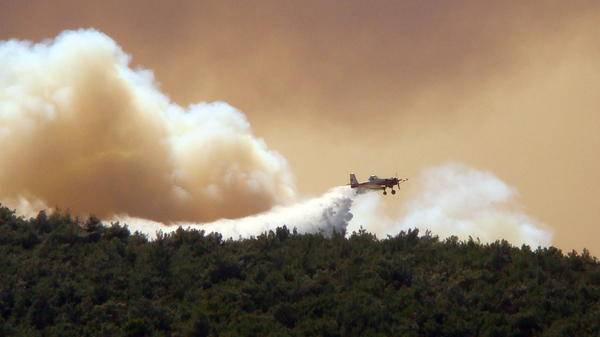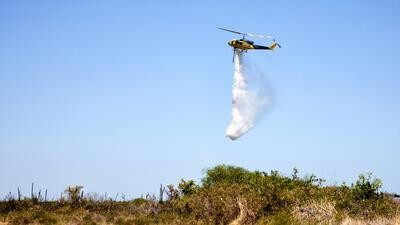Aerial firefighting in Greece

The rapid firefighting water bombers of Greece play a vital role in fire suppression during the hot summer months
European aerial firefighting rescue services have been hard pressed this summer, with hot and dry regions around the Mediterranean seeing record temperatures. Greece is no exception, with a solid force of aircraft and helicopters working hard during the summer months. Peter Ten Berg spoke to Hellenic Air Force Major Petros Kazakos about the fleet.
Most common are the large-sized, bright red-yellow color Canadair-Bombardier CL-215 Scooper and CL-415 Superscooper, which operate out of the water. Nevertheless, there is another important asset in the Greek governmental firefighting fixed wing inventory – the PZL M-18 Dromader aircraft. AirMed&Rescue was offered a close look at Tatoi-Dekelia Air Force Base, just north of Athens, home base of the Dromader flying unit 359 Public Services Air Support Squadron (MAEDY).
Major Petros Kazakos, one of the Dromader pilots, spoke to AirMed&Rescue in April, before the heat of the summer reached the Southern Mediterranean nation. It is almost the end of the off-season, just before the aircraft will spread out over the country for their summer detachments from May to October. This is a very busy period for the unit, as final maintenance is carried out on the aircraft, pilots are doing their last training sorties, and the squadron is making the final preparations for their summer deployments.
The squadron has 21 aircraft, 18 PZL M-18B single seaters, and three PZL M-18BS double seaters for pilot training. The Dromaders were built by the Polish PZL-Mielec aircraft plant, currently part of Sikorsky Aircraft Company and delivered in 1983. The aircraft are equipped with a single rotary piston PZL-KALISZ model Asz-621-M18 engine, giving the aircraft 967 horsepower and a top speed of 228 kmph.
Since their delivery, the Dromaders have seen many Greek-made improvements, such as modifications to the wing fuel tanks, increasing the capacity by more than 70 per cent, resulting in a longer flight time – from 2.5 to 4.5 hours. Additional improvements have focused on the aircraft’s overall agility, with the installation of new flaps that have an extended angle capacity.
Major Kazakos also mentions that the Hellenic Dromaders are different to those from other operators as they were modified by 359 MAEDY, who installed a hydraulic water drop hatch instead of a mechanical one. This provided the pilots with the extra option of releasing the water over a three-to-12-second time frame, instead of all at once. Furthermore, by installing a foam generator in the water tank, the pilots were given a selection of tools with which to fight fires.

The Dromaders have an airborne response time of 15 minutes, during which time the pilot makes a provisional flight plan towards the reported fire location. Ground crew fill the water tank shortly before take off to save the aircraft frame from being exposed to a continuous high waterload for an unnecessarily long time. A portable GPS is used to reach the fire location.
Once on scene, the pilots first fly an orbit above the fire location to orientate on wind direction, identify obstacles such as electric cables and pylons, and examine area height differences in order to determine the right approach from which to attack the fire. The minimum height where the pilots drop their water load is 10 metres, which gives them enough altitude to avoiding flying through smoke fumes and to keep a smoke-free view.
Major Kazakos told AirMed&Rescue that above all, it is practice that allows the crew to do their jobs safely. “It is just training and experience which makes you flexible to adapt to every situation and do an accurate and precise water bombing where needed.”
This article originally appeared in the November 2019 issue of AirMed&Rescue

November 2019
Issue
The price is right – or is it? The cost of insuring medical flights
Reality in a virtual world - The evolution of virtual and augmented reality
A dying breed - Pilot retention in the air medical sector
Dromaders from Athens - Greek fire-fighting assets
Mind your head - Decompressive craniectomy flights
Interview: Matthew Napiltonia, Global Rescue
Provider Profile: Med-Trans Corp
Case Study: MEDEVAC.Flights describes a difficult repatriation from China
Peter Ten Berg
Inspired by the dynamics of aviation and a passion for photography, Peter accompanies aircraft and helicopter crews to capture them at work and hear their story for his exclusive reports. His focus is on military aviation as well as governmental subjects including HEMS, SAR, UAV and rescue.




